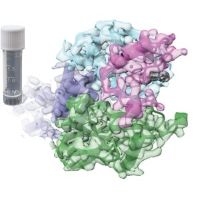Specification
| Organism | Mus musculus (Mouse) |
| Expression Host | E.coli |
| Tag Info | N-terminal 6xHis-SUMO-tagged |
| Purity | Greater than 85% by SDS-PAGE |
| Uniprot ID | O35235 |
| Gene Names | Tnfsf11 |
| Alternative Names | Osteoclast differentiation factor Short name:ODF Osteoprotegerin ligand Short name:OPGL Receptor activator of nuclear factor kappa-B ligand Short name:RANKL TNF-related activation-induced cytokine Short name:TRANCE CD_antigen: CD254 |
| Expression Region | Extracellular Domain(70-316aa ) |
| Molecular Weight | 43.9 kDa |
| Protein Sequence | YFRAQMDPNRISEDSTHCFYRILRLHENADLQDSTLESEDTLPDSCRRMKQAFQGAVQKELQHIVGPQRFSGAPAMMEGSWLDVAQRGKPEAQPFAHLTINAASIPSGSHKVTLSSWYHDRGWAKISNMTLSNGKLRVNQDGFYYLYANICFRHHETSGSVPTDYLQLMVYVVKTSIKIPSSHNLMKGGSTKNWSGNSEFHFYSINVGGFFKLRAGEEISIQVSNPSLLDPDQDATYFGAFKVQDID |
| Form | Liquid or Lyophilization |
| Buffer | The default storage buffer is Tris/PBS-based buffer, 5%-50% glycerol if the delivery form is liquid. The lyophilization buffer is Tris/PBS-based buffer, 6% Trehalose, pH 8.0 if the delivery form is lyophilized powder. Please contact us if you have any special requirment. |
| Reconstitution | Please reconstitute protein in deionized sterile water and we recommend that briefly centrifuge thevial prior to opening the vial .We recommend aliquot for long-term storage at -20℃/-80℃. |
Background
| Relevance | Cytokine that binds to TNFRSF11B/OPG and to TNFRSF11A/RANK. Osteoclast differentiation and activation factor. Augments the ability of dendritic cells to stimulate naive T-cell proliferation. May be an important regulator of interactions between T-cells and dendritic cells and may play a role in the regulation of the T-cell-dependent immune response. May also play an important role in enhanced bone-resorption in humoral hypercalcemia of malignancy. |
| Involvement in Disease | Deficiency in Tnfsf11 results in failure to form lobulo-alveolar mammary structures during pregnancy, resulting in death of newborns. Trance-deficient mice show severe osteopetrosis, with no osteoclasts, marrow spaces, or tooth eruption, and exhibit profound growth retardation at several skeletal sites, including the limbs, skull, and vertebrae and have marked chondrodysplasia, with thick, irregular growth plates and a relative increase in hypertrophic chondrocytes. |
| Subcellular Location | Isoform 1: Cell membrane, Single-pass type II membrane protein, SUBCELLULAR LOCATION: Isoform 2: Cell membrane, Single-pass type II membrane protein, SUBCELLULAR LOCATION: Isoform 3: Cytoplasm, SUBCELLULAR LOCATION: Tumor necrosis factor ligand superfamily member 11, soluble form: Secreted |
| Protein Families | Tumor necrosis factor family |
| Tissue Specificity | Tnfsf11 |
QC Data
| Note | Please contact us for QC Data |
| Product Image (Reference Only) |  |

